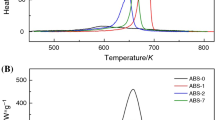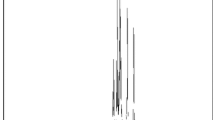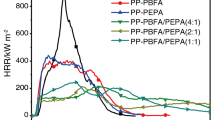Abstract
Hexakis(4-nitrophenoxy) cyclotriphosphazene (HNTP) was added to polycarbonate (PC) as intumescent flame retardant. In order to get high-flame-retardant PC composite with a small quantity of addition, potassium diphenylsulfone sulfonate (KSS) was added to PC as synergetic flame retardant. The flame retardancy and thermal degradation behavior of composites was investigated with limiting oxygen index (LOI), UL-94 vertical burning test, microscale combustion calorimeter (MCC), and thermogravimetric analysis (TG). TG coupled with FTIR (TG/FTIR) was used to research their gaseous products. Scanning electron microscopy analyses and FTIR spectrophotometer were used to study the structure of residual char. But the flammability properties of PC systems indicated the synergistic was instead of antagonistic effects. The antagonistic behaviors between HNTP and KSS were further researched by MCC, TG, and FTIR. The antagonism of KSS was quantified by Lewin M’s synergistic effectiveness parameter, calculated from sample LOI data.










Similar content being viewed by others
References
Levchik SV, Weil ED. Flame retardants in commercial use or in advanced development in polycarbonates and polycarbonate blends. J Fire Sci. 2006;24(2):137–51.
Levchik SV, Weil ED. Overview of recent developments in the flame retardancy of polycarbonates. Polym Int. 2005;54(7):981–98.
Liu S, Ye H, Zhou Y, et al. Study on flame-retardant mechanism of polycarbonate containing sulfonate-silsesquioxane-fluoro retardants by TGA and FTIR. Polym Degrad Stab. 2006;91(8):1808–14.
Huang X, Ouyang X, Ning F, et al. Mechanistic study on flame retardance of polycarbonate with a small amount of potassium perfluorobutane sulfonate by TGA–FTIR/XPS. Polym Degrad Stab. 2006;91(3):606–13.
Singler RE, Hagnauer GL, Schneider NS, et al. Synthesis and characterization of polyaryloxyphosphazenes. J Polymer Sci Polymer Chem Edition. 1974;12(2):433–44.
Yang Y, Kong W, Wang Y, et al. Synthesis of tris (phenoxy) trifluorocyclotriphosphazenes and study of its effects on the flammable, thermal, optical, and mechanical properties of bisphenol-A polycarbonate. J Therm Anal Calorim. 2015;122(2):805–16.
Kumar D, Fohlen GM, Parker JA. The curing of epoxy resins with aminophenoxycyclotriphosphazenes. J Polym Sci, Part A: Polym Chem. 1986;24(10):2415–24.
Kumar D, Khullar M, Gupta AD. Synthesis and characterization of novel cyclotriphosphazene-containing poly(ether imide)s. Polymer. 1993;34(14):3025–9.
Zhang T, Cai Q, Wu DZ, et al. Phosphazene cyclomatrix network polymers: some aspects of the synthesis, characterization, and flame-retardant mechanisms of polymer. J Appl Polym Sci. 2005;95(4):880–9.
Çoşut B, Hacıvelioğlu F, Durmuş M, et al. The synthesis, thermal and photophysical properties of phenoxycyclotriphosphazenyl-substituted cyclic and polymeric phosphazenes. Polyhedron. 2009;28(12):2510–6.
Kourtides DA. Thermochemical and flammability properties of some thermoplastic and thermoset polymersa review. Polymer Plastics Technol Eng. 1978;11(2):159–98.
Calleman CJ, Bergmark E, Costa LG. Acrylamide is metabolized to glycidamide in the rat: evidence from hemoglobin adduct formation. Chem Res Toxicol. 1990;3(5):406–12.
Levchik SV, Camino G, Costa L, et al. Mechanism of action of phosphorus -based flame retardants in nylon 6. I. Ammonium polyphosphate. Fire Mater. 1995;19(1):1–10.
Yuan D, Yin H, Cai X. Synergistic effects between silicon-containing flame retardant and potassium-4-(phenylsulfonyl) benzenesulfonate (KSS) on flame retardancy and thermal degradation of PC. J Therm Anal Calorim. 2013;114(1):19–25.
Nodera A, Kanai T. Thermal decomposition behavior and flame retardancy of polycarbonate containing organic metal salts: effect of salt composition. J Appl Polym Sci. 2004;94(5):2131–9.
Lewin M. Synergistic and catalytic effects in flame retardancy of polymeric materials—an overview. J Fire Sci. 1999;17(1):3–19.
He J, Cai G, Wilkie CA. The effects of several sulfonates on thermal and fire retardant properties of poly (methyl methacrylate) and polystyrene. Polym Adv Technol. 2014;25(2):160–7.
Lewin M. Synergism and catalysis in flame retardancy of polymers. Polym Adv Technol. 2001;12(3–4):215–22.
Lyon RE, Walters RN. Pyrolysis combustion flow calorimetry. J Anal Appl Pyrol. 2004;71(1):27–46.
Schartel B, Pawlowski KH, Lyon RE. Pyrolysis combustion flow calorimeter: a tool to assess flame retarded PC/ABS materials? Thermochim Acta. 2007;462(1):1–14.
Shi Y, Kashiwagi T, Walters RN, et al. Ethylene vinyl acetate/layered silicate nanocomposites prepared by a surfactant-free method: enhanced flame retardant and mechanical properties. Polymer. 2009;50(15):3478–87.
Tang Z, Li Y, Zhang YJ, et al. Oligomeric siloxane containing triphenyl phosphonium phosphate as a novel flame retardant for polycarbonate. Polym Degrad Stab. 2012;97(4):638–44.
Tao K, Li J, Xu L, et al. A novel phosphazene cyclomatrix network polymer: design, synthesis and application in flame retardant polylactide. Polym Degrad Stab. 2011;96(7):1248–54.
Lee LH. Mechanisms of thermal degradation of phenolic condensation polymers. I. Studies on the thermal stability of polycarbonate. J Polym Sci Part A Polymer Chem. 1964;2(6):2859–73.
Jang BN, Wilkie CA. The thermal degradation of bisphenol A polycarbonate in air. Thermochim Acta. 2005;426(12):73–84.
Jang BN, Wilkie CA. A TGA/FTIR and mass spectral study on the thermal degradation of bisphenol A polycarbonate. Polym Degrad Stab. 2004;86(3):419–30.
Uyar T, Tonelli AE, Hacaloğlu J. Thermal degradation of polycarbonate, poly (vinyl acetate) and their blends. Polym Degrad Stab. 2006;91(12):2960–7.
Levchik SV, Camino G, Luda MP, et al. Thermal decomposition of cyclotriphosphazenes. I. Alkyl-aminoaryl ethers. J Appl Polym Sci. 1998;67(3):461–72.
Acknowledgements
We would like to thank the following for their generous supports : Dr. Jingxin Lei, for providing the FTIR instrumentation; the Experiment center of Polymer science and engineering academy, Sichuan University; National Natural Sciences Foundation of China, Grant No. 50973066; and “the Fundamental Research Funds for the Central Universities,” Project No. 2014NYB03.
Author information
Authors and Affiliations
Corresponding author
Rights and permissions
About this article
Cite this article
Yang, Y., Liu, J. & Cai, X. Antagonistic flame retardancy between hexakis(4-nitrophenoxy) cyclotriphosphazene and potassium diphenylsulfone sulfonate in the PC system. J Therm Anal Calorim 126, 571–583 (2016). https://doi.org/10.1007/s10973-016-5519-2
Received:
Accepted:
Published:
Issue Date:
DOI: https://doi.org/10.1007/s10973-016-5519-2




